Planting trees in Ghana
A new project from Click A Tree
- AutorIn: Chris Kaiser
- Datum:
- Kategorie: Hacks, tips, knowledge
Share with your community on LinkedIn now:
We have been planting trees in Ghana since September 2019. Today we answer all the questions: what, where, how, when and above all why. After all, the why is by far the most exciting aspect of our reforestation project in Ghana, alongside the how.
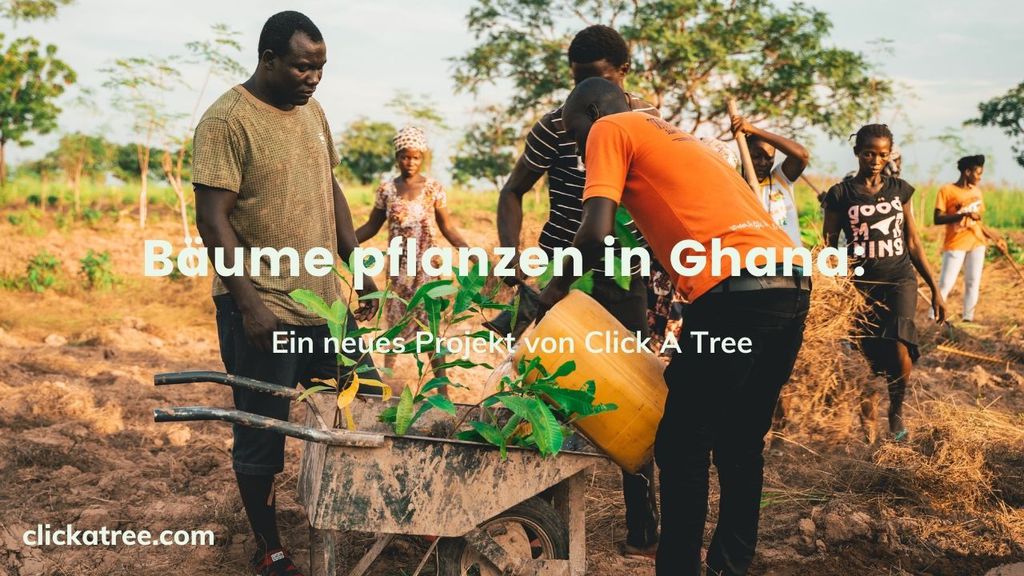
Planting trees is a topic that few people in the western world deal with on a daily basis. That’s why we’re taking the time today to explain to you in detail where and which trees we plant in Ghana, when we do it and, above all, why we do it.
Planting trees does much more than you might think at first glance. Especially when it’s done right.
Life in central Ghana
On this clear November night, the Milky Way is huge and as wonderfully visible as it usually is in elaborately processed images. The air is still dewy after today’s rainfall.
The glow of the campfire envelops the faces all around in warm light. Some of those seated are engrossed in conversation. Others quietly enjoy the magical atmosphere. They are all happy and satisfied after a long, busy day.
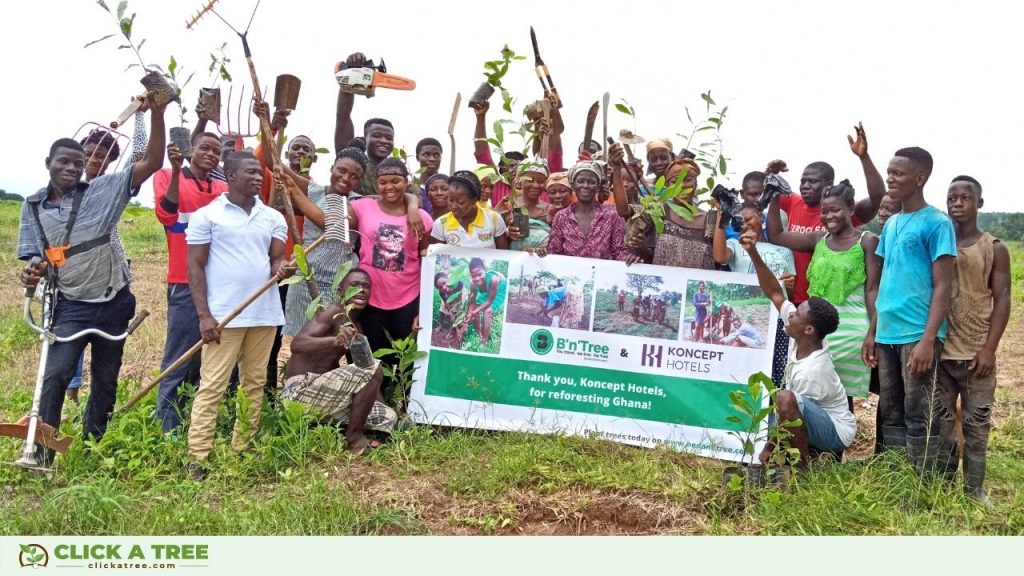
Suddenly a clear voice rises above the quiet babble of voices. She launches into a local folk song.
After the first few bars, the babble of voices falls silent. Others present join in and in no time at all a harmonious melody is heard from numerous throats. It floats gently towards the sea of stars.
The workers on the tree plantation sing and dance long into the night. They are happy.
Happy to have finally found a permanent, fairly paid job. About the fact that they can get up in the morning without worrying about what they are going to eat today. Happy to finally have hope again.
This is the result of your support for our tree planting project in Ghana. You can achieve something so great with so little effort.
Planting trees in Ghana
Ghana is located in western Africa on the Atlantic coast, surrounded by the Ivory Coast, Burkina Faso and Togo.
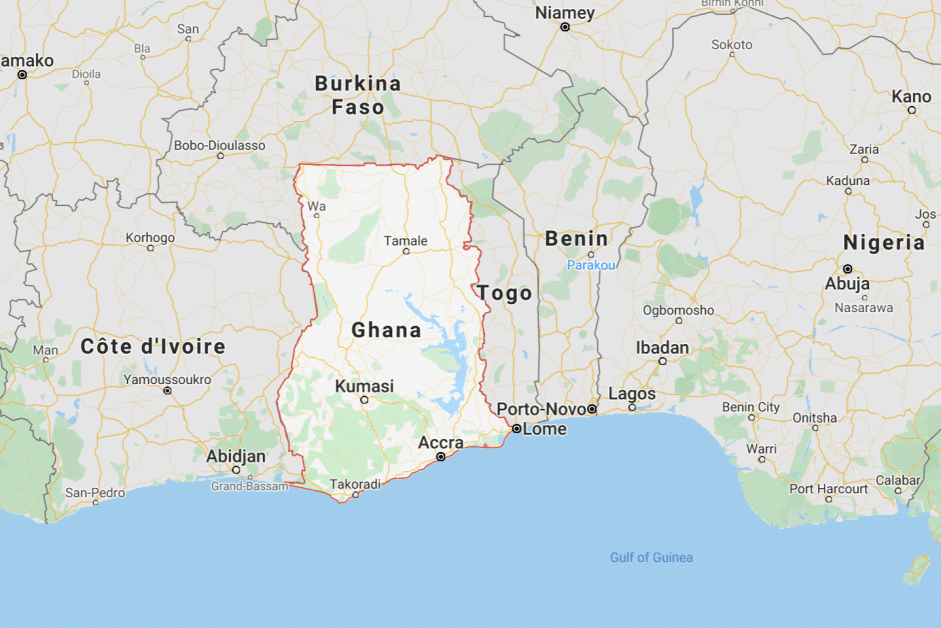
It is a country that few people are familiar with. Although every chocolate lover should always have it on their radar: Together with its neighbors from the Ivory Coast, Ghana produces over 60% of the world’s cocoa harvest.
Nevertheless, Ghana is ranked just 140th in the UN Human Development Index. In comparison: Germany ranks 4th.
29 million people live here. In a country that is around two thirds the size of Germany.
Living conditions here are more difficult than in many other countries. Jobs are not always easy to come by and are often not particularly well paid.

It is certainly not an easy life here in Ghana. And yet the residents live it with great joie de vivre.
To support this joy and even turn it into hope, we decided to plant trees in Ghana too.
The where: Where we plant trees in Ghana
The Click A Tree tree planting project is located in the Volta region in central Ghana, near the small village of Kyinderi.
We are 10 hours north of Accra, the capital, and 5 hours south of Tamale. The area is actually very remote.
However, the consequences of climate change are already being felt here too. Rainfall is decreasing and unpredictable, making it difficult to plan traditional agriculture. Many lands lie fallow, many people are unemployed.
1,000 acres of land are available here for reforestation. A gigantic project – and one that gives the region a lot of hope.
And rightly so. Because with the right strategy, planting trees can do a lot of good.

The why: Why does Click A Tree plant trees in Ghana?
As already mentioned, living conditions in Ghana are more difficult than in Germany. The population is looking for work – and we are creating this with our tree planting project.
But there’s more: thanks to a prudent strategy, we not only create full-time jobs and income for the people who plant and care for our trees.
We combine livestock farming, arable farming and reforestation in a unique way to secure both food and work for the local community in the long term – and to build up a self-sufficient forest at the same time.
We also support a local entrepreneurship school where unemployed young people learn how to create a better future for themselves.
It is a holistic, sustainable approach that we are pursuing with our reforestation project in Ghana. After all, a project like “Planting Trees”, which is set to run for decades, can only work if it is actually sustainable in its entirety.
Of course, planting trees does not solve every single problem facing Ghanaians. But it is a very good start.

The ecological benefits of planting trees in Ghana
The ecological benefits of planting trees seem obvious: You create new, self-sufficient forests as a habitat for a variety of animals. At the same time, the trees absorb the climate-damaging carbon dioxide, store the carbon from this and release the oxygen again. The reforestation project is therefore actively combating climate change. So far, so good.
But there’s more: planting trees has been proven to restore water cycles. This is particularly valuable in tropical countries, which are often characterized by rainy and dry seasons.
The extensive root system of the forest stores water during periods of rain and releases it again in parts during drier periods. This secures the region’s water supply all year round.
At the same time, cloud formation is distributed more evenly throughout the year. Clouds have the valuable side effect of reflecting the sun’s rays and thus keeping the earth cool.
Trees also prevent land erosion and desertification and provide a home for millions of creatures, thus actively contributing to the preservation of our biodiversity.

The social benefits of planting trees in Ghana
As already mentioned, planting trees creates full-time jobs and income. For this reason, we expressly refrain from volunteering.
We want all our workers to be fairly remunerated for their efforts. And not only for the planting of the trees, but also for their long-term care.
Furthermore, thanks to our holistic approach here in Ghana, the local community also benefits from crop yields and livestock farming. You can find out more about this below.
Promoting entrepreneurs with tree planting
And as if all that wasn’t enough, the tree planting project here in Ghana also supports a local business school. Unemployed young people learn the basics of entrepreneurship here, such as computer skills, product design, bookkeeping and marketing.
The students also gain valuable practical experience: they build organic toilets, drive tractors, learn how to beekeep or create jewelry and clothing by hand from local fabrics.
And all this free of charge! The neediest students even receive accommodation and food – also free of charge.
In return for their training, the students work on the farm from time to time. This pays for their studies and provides them with further valuable practical knowledge.
They all dream of being able to create a better future for themselves, their families and their communities. And thanks to a simple measure like “planting trees”, this dream is now becoming a reality.
So when you plant trees in Ghana, you are not only doing our planet a huge favor. At the same time, you are helping to keep the entrepreneurial school in Kyinderi alive – for many young people, it is the only hope they have.

The How: How we plant trees in Ghana: An introduction to syntropic agriculture
Another special feature of our tree planting project in Ghana is the reforestation method used here: Its founder, the Swiss Ernst Götsch, calls it “Syntropic Agriculture”.
In our further development, which is being used here in Ghana, it combines agriculture, livestock farming and reforestation in a unique, natural and sustainable way.
The advantages of syntropic agriculture
“Syntropic agriculture” may sound extremely creative, but it’s actually the most logical thing in the world. This is exactly what Mother Nature would do.
This creates extremely valuable symbioses. Plants grow faster, the soil is richer in nutrients and harvests are higher in the long term.
And, incidentally, you create a self-sufficient forest. It serves as a carbon sink, cools the planet, restores natural water cycles, prevents soil erosion and is home to millions of creatures.
What more could you want?
How syntropic agriculture works
Syntropic agriculture is much more than just a creative name. You could almost call it a science. But don’t worry, we’ll explain to you in the simplest possible way how syntropic agriculture works.
For syntropic agriculture to work, you need a plan. After all, you want to plant both a functioning orchard and a self-sufficient forest at the same time – and ideally in such a way that all the trees benefit from each other.
Roughly speaking, you need two types of trees: “forest trees” and “fruit trees”.
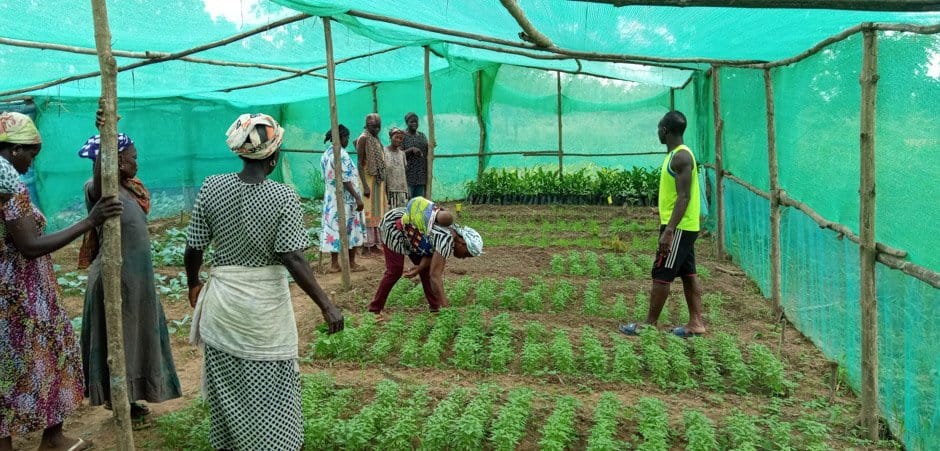
Forest trees are all those trees that later form the self-sufficient forest. These include karite trees (also known as shea nut trees), mahogany and rivet trees as well as mighty baobabs. The latter can live for thousands of years!
Fruit trees are all those trees that have a short and medium-term benefit. Here in Ghana, these include banana trees, cashews, moringa, mangoes, gmelina and citrus fruits.
These are the props. Now to the performance:
The fruit trees are planted in a first row, with a distance of 1-2 meters between the trees. Sensible planning is also important here, as not all fruit trees are planted to produce fruit: Banana trees, for example, store water. They are later cut down and covered under the mulch to provide the other trees with water even in drier times.
Gmelina form very large leaves and are therefore excellent biomass producers. Their leaves serve as mulch.
Sweet potatoes are also grown between these trees. These are good against weeds, can be harvested every three months and are made into the finest bread here in Ghana.
A second row of trees is planted 1-2 meters away from this first row. This time it’s forest trees. Of course, they need a little more space to grow, as they will one day become gigantic jungle giants. So you plant a forest tree every 2-6 meters.
And then fruit trees again in the third row. And so on, and so on, until the 1,000 acres of land in Ghana are fully planted.
Syntropic agriculture and livestock farming
So much for syntropic agriculture in the original sense. In Ghana, we go one step further and add local livestock farming to the mix.
Because grass grows between these rows of trees. The cows love it, graze between the rows of trees and eagerly leave behind cow pats.
Next up are the rabbits. They feast on the small blades of grass left behind by the cows and leave their rabbit droppings behind in return.
In the meantime, Mother Nature had a little time to deal with the cow pats. As a result, various worms, maggots and larvae have made themselves at home here.
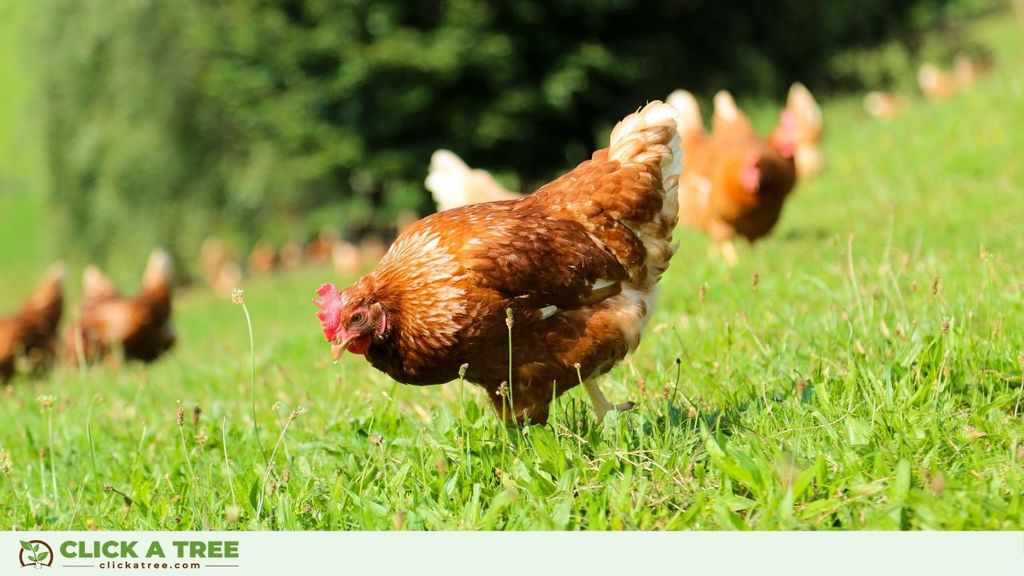
And to the delight of the chickens. They come third. They obsessively pick everything imaginable out of the cow dung, spreading all the valuable nutrients from the legacies of their predecessors over a wide area.
It is practically the perfect fertilization cycle – developed and driven by Mother Nature. 100% organic. And in the end, you not only have happy, free-range and lush animals, but also a much more nutrient-rich and fertile soil – for the benefit of both fruit and forest trees.
The positive long-term effects of syntropic agriculture
Syntropic agriculture is a long-term strategy. In the short term, monocultures usually produce better yields, which is unfortunately why many farmers neglect syntropic agriculture.
However, with monocultures, the soil is depleted after only 2-3 years, the land is left fallow and more virgin forests are cleared to create more plantations.
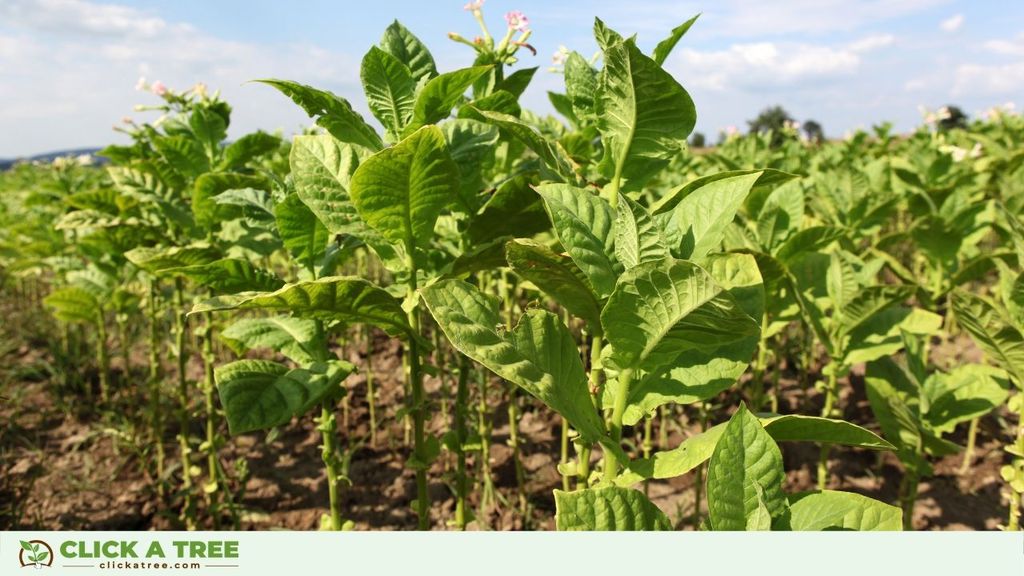
Syntropic agriculture thinks ahead. Thanks to the symbiosis of forest and fruit trees, the soil remains fertile in the long term. What’s more, in the long term the yields are even higher than from commercial monocultures, as the symbioses of the trees are then at their best.
However, syntropic agriculture also requires long-term work. To keep both the fruit and forest trees productive, they are trimmed regularly.
Because if a tree is not trimmed, it feels “outgrown” and becomes “lazy”, i.e. grows more slowly. As long as trees are trimmed regularly, growth is increased. It’s a bit like a good coach who always motivates you to perform even better.
And once again, this is great in two senses: not only do you achieve higher crop yields in the long term, but you also secure long-term employment for the workers. Really good, isn’t it?
And that’s not all: thanks to the combination of syntropic agriculture and livestock farming described above, farmers here in Ghana no longer need to buy fertilizer.
In traditional agriculture, fertilizer has to be bought at a high price. Up to 80% of the turnover is spent on fertilizer and seeds alone; the farmer is only allowed to keep 20%.
Syntropic farming costs a little more at the beginning, but after 2 years you reach break-even and can keep 100% of the income from then on.
The What: Which tree species does Click A Tree plant in Ghana?
As already mentioned, we plant a large number of different tree species in Ghana.
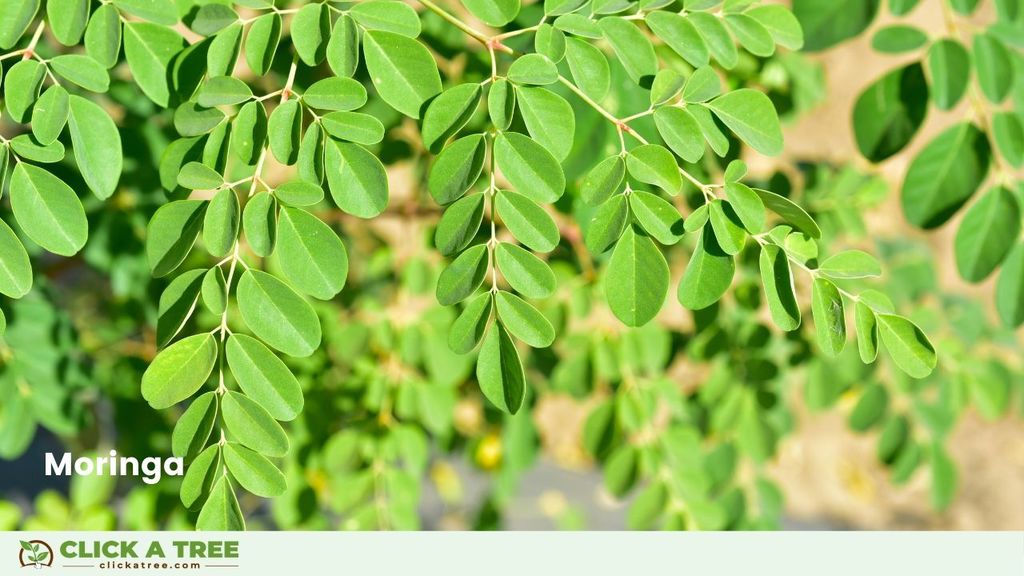
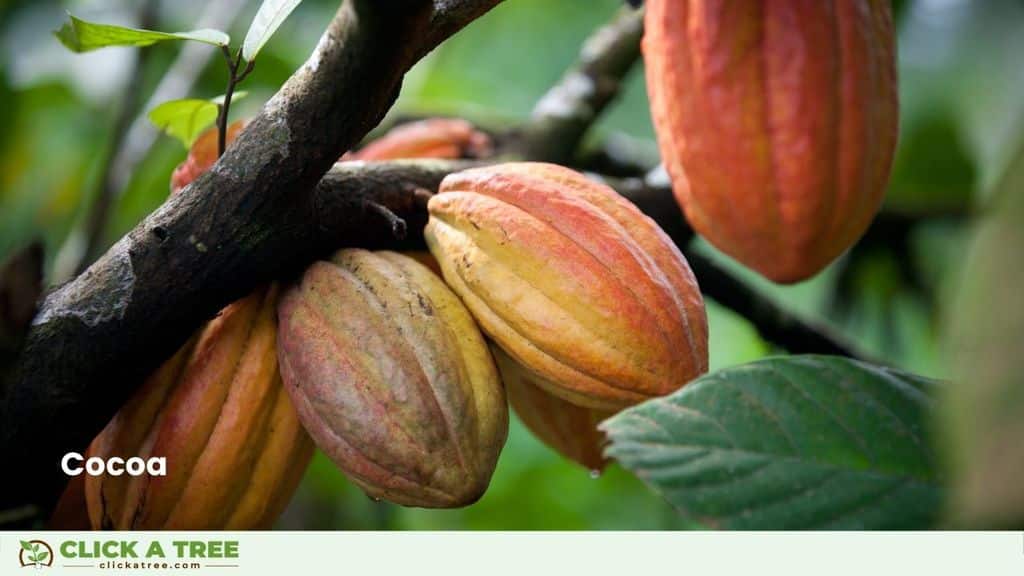
The fruit trees here include bananas, mangoes, citrus fruits, moringa and cashews. Cocoa or coffee are also conceivable in the future.
The forest trees include karite trees (shea nut), mahogany, kapch, davadava, atram and baobabs. Baobabs in particular grow very slowly and are cared for by us for at least twelve years.
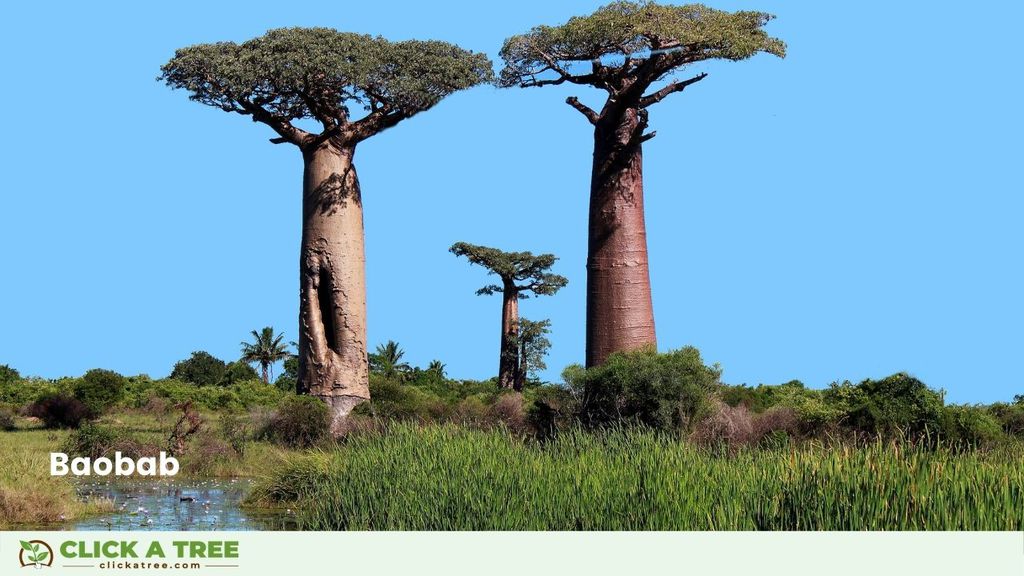
The result is worth it: a single baobab tree can live for up to 3,000 years and bind up to 3 tons of CO2! If that’s not a first-class achievement in the fight against climate change, then we don’t know what is.
In total, we plant over 20 different tree species here in Ghana to achieve the best possible result.
The when: When are the trees planted in Ghana?
In Ghana, we plant trees all year round. After all, we want to offer our employees a reliable full-time income.
Due to the weather conditions, planting out only makes sense between April and September. Planting therefore takes place in the nursery between October and March in order to prepare the small seedlings as well as possible for their life in the wild.
And this pays off: the survival rate of the trees here is between 80-90%. And of course, if a tree does not survive despite intensive care, we will replant it free of charge. If you plant a tree with us, then it is a tree that will survive. Anything else would be strange.
Let’s plant trees in Ghana!
So. Now you know everything there is to know about planting trees in Ghana.
You know that this is a long-term project that will benefit the entire region. You know that these trees slow down climate change, which benefits us all.
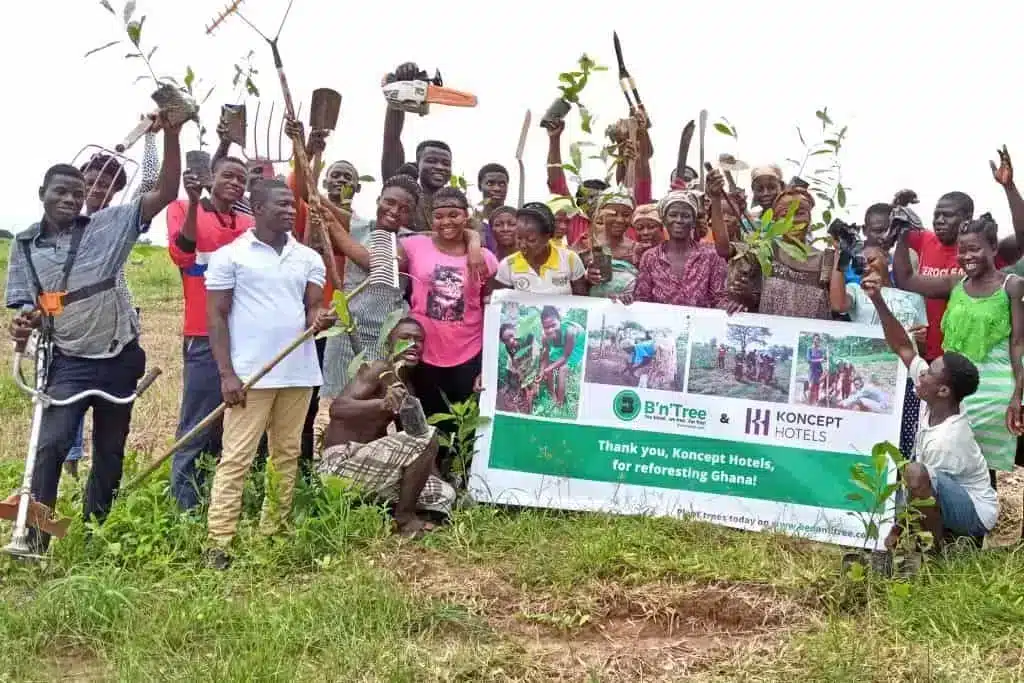
And you know that here on Click A Tree you can have a tree planted in Ghana right now.
So what are you waiting for?
If you like, we can keep you up to date on exciting things happening in Ghana and all our other projects around the world via our newsletter.
We’ll even plant a tree for you if you sign up for our newsletter.
[mailerlite_form form_id=”8″]
Planting trees for companies
Finally, we would like to encourage you to consider planting trees in Ghana for your company or to discuss it with your boss.
Thanks to the first-class support of the local team, we can create personalized marketing material from small quantities of planted trees, which we make available to you for the internal and external communication of your support.
This means that you also benefit from this commitment, as you can acquire new customers and retain existing customers for longer.
Sustainable commitment also increases employee motivation, as many people today want to do a job that makes sense. And if you plant trees in Ghana in the future, it will make sense on so many levels. Don’t you agree?
You may also be interested in: 40+ tips for more sustainable companies.
What do you think about planting trees in Ghana?
Now to you: What do you think about planting trees in Ghana? Does that make sense? Do you have any unanswered questions? Or ideas on how to plant trees even more efficiently?
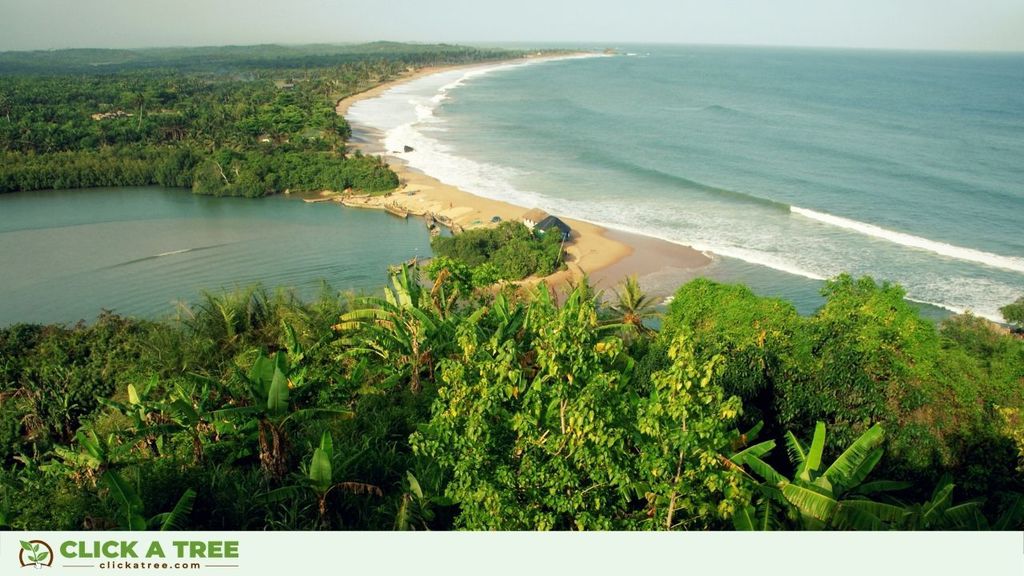
Tell us in the comments. Or share your knowledge and ideas with our community in our Facebook discussion about planting trees in Ghana.
And of course you are also welcome to follow us on Instagram.
Thank you for making all this possible! Our world needs more people like you.
Stay as great as you are. And look forward to our next updates.